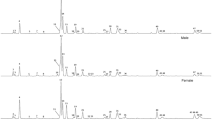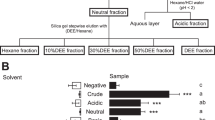Abstract
The convergent lady beetle (Hippodamia convergens) forms large overwintering aggregations at revisited montane microsites far removed from their summer foraging grounds. Although orientation responses to visual and altitudinal features of habitat can explain the arrival of migrants at the general overwintering macrosite, the role that pheromones play in the accumulation of individuals in inconspicuous hibernacula microsites is not fully understood. Through two-choice bioassays and gas chromatography and mass spectrometry, we found that H. convergens orient towards hydrocarbons previously deposited on their walking surfaces by conspecifics. n-Tricosane (C23) is primarily responsible for this chemically-mediated orientation. Footprint extracts, as well as C23 alone, induce the eventual accumulation in the field of migrant H. convergens at artificial hibernacula, confirming their probable role as aggregation signals. Aggregations persisted over many days when footprint extracts were applied in conjunction with the previously identified 2-isobutyl-3-methoxypyrazine (IBMP) aggregation pheromone. The C23 hydrocarbon functions as a pheromone that interacts with responses to methoxypyrazines to effectively mediate formation of persistent aggregations of diapausing conspecifics at specific microsites. Also discussed is the potential effect that C23 has as a persistent scent marker in establishing the traditional use of hibernacula.






Similar content being viewed by others
References
Arnaud L, Spinneux Y, Haubruge E (2003) Preliminary observations of sperm storage in Adalia bipunctata: sperm size and number. Appl Entomol Zool 38:301–304
Bartelt RJ (2010) Volatile hydrocarbon pheromones from beetles. In: Blomquist GJ, Bagnéres A-G (eds) Insect hydrocarbons: biology, biochemistry, and chemical ecology. Cambridge University Press, Cambridge, pp 448–476
Bennett LE, Lee RE (1989) Simulated winter to summer transition in diapausing adults of the lady beetle (Hippodamia convergens). Physiol Entomol 14:361–367
Blomquist GJ (2010) Biosynthesis of cuticular hydrocarbons. In: Blomquiste GJ, Bagnéres A-G (eds) Insect hydrocarbons: biology, biochemistry, and chemical ecology. Cambridge University Press, Cambridge, pp 35–52
Blomquist GJ, Bagnéres A-G (2010) Insect hydrocarbons: biology, biochemistry, and chemical ecology. Cambridge University Press, Cambridge
Blum MS (1996) Semiochemical parsimony in the Arthropoda. Annu Rev Entomol 41:353–374
Boyd R, Richerson PJ (1985) Culture and the evolutionary process. University of Chicago Press, Chicago
Brown AE, Riddick EW, Aldrich JR, Holmes WE (2006) Identification of (−)-β-caryophyllene as a gender-specific terpene produced by the multicolored Asian lady beetle. J Chem Ecol 32:2489–2499
Childress MJ, Hernkind WF (2001) The guide effect influence on the gregariousness of juvenile Caribbean spiny lobsters. Anim Behav 62:465–472
Copp NH (1983) Temperature-dependent behaviours and cluster formation by aggregating ladybird beetles. Anim Behav 31:424–430
Cudjoe E, Wiederkehr TB, Brindle ID (2005) Headspace gas chromatography–mass spectrometry: a fast approach to the identification and determination of 2-alkyl-3-methoxypyrazine pheromones in ladybugs. Analyst 130:152–155
Deneubourg J-L, Lioni A, Detrain C (2002) Dynamics of aggregation and emergence of cooperation. Biol Bull 202:262–267
Donaldson ZR, Grether GF (2007) Tradition without social learning: scent-mark-based communal roost formation in a Neotropical harvestman (Prinostemma sp.). Behav Ecol Sociobiol 61:801–809
Durieux D, Fischer C, Brostaux Y, Sloggett JJ, Deneubourg J-L, Vandereycken A, Joie E, Watchelet J-P, Lognay G, Haubruge E, Verheggen FJ (2012) Role of long-chain hydrocarbons in the aggregation behaviour of Harmonia axyridis (Pallas) (Coleoptera: Coccinellida). J Insect Physiol 58:801–807
Durieux D, Fassotte B, Vanderplank M, Deneubourg J-L, Fischer C, Lognay G, Haubruge E, Verheggen FJ (2013) Substrate marking by an invasive ladybeetle: seasonal changes in hydrocarbon composition and behavioural responses. PLoS One 8:e61124
Dussutour A, Deneuboug J, Fourcassie V (2005) Amplification of individual preferences in a social context: the case of wall-following in ants. Proc R Soc Biol Sci 272:705–714
Evans EW (2004) Habitat displacement of North American ladybirds by an introduced species. Ecology 85:637–647
Greene MC, Stamps JA (2001) Habitat selection at low population densities. Ecology 82:2091–2100
Hagen KS (1962) Biology and ecology of predaceous Coccinellidae. Annu Rev Entomol 7:289–326
Hemptinne JL, Dixon AF (2000) Defence, oviposition and sex: semiochemical parsimony in two species of ladybird beetles (Coleoptera, Coccinellidae)? A short review. Eur J Entomol 97:443–447
Hemptinne JL, Lognay G, Doumbia M, Dixon AF (2001) Chemical nature and persistence of the oviposition deterring pheromone in the tracks of the larvae of the two spot ladybird, Adalia bipunctata (Coleoptera: Coccinellidae). Chemoecology 11:43–47
Hodek I, Honêk A (1996) Ecology of Coccinellidae. Kluwer, Boston
Honěk A, Martinková Z, Pekár S (2007) Aggregation characteristics of three species of Coccinellidae (Coleoptera) at hibernation sites. Eur J Entomol 104:51–56
Jeanson R, Deneubourg J-L (2007) Conspecific attraction and shelter selection in gregarious insects. Am Nat 170:47–58
Kosaki A, Yamaoka R (1996) Chemical composition of footprints and cuticular lipids of three species of lady beetles. Jpn J Appl Entomol Zool 40:47–53
Lockey KH (1988) Lipids of the insect cuticle: origin, composition and function. Comp Biochem Physiol 89B:595–645
Majerus MEN (1997) How is Adalia bipunctata (Linn.) (Coleoptera: Coccinellidae) attracted to overwintering sites? Entomol 116:602–615
Michaud JP, Jyoti JL (2007) Repellency of conspecific and heterospecific larval residues to Hippodamia convergens (Coleoptera: Coccinellidae) ovipositing on sorghum plants. Eur J Entoml 104:399–405
Nalepa CA, Kennedy GG, Brownie C (2005) Role of visual contrast in the alighting behavior of Harmonia axyridis (Coleoptera: Coccinellidae) at overwintering sites. Environ Entomol 34:425–431
Pettersson J, Ninkovic V, Glinwood R, Birkett MA, Pickett JA (2005) Foraging in a complex environment - semiochemicals support searching behaviour of the seven spot ladybird. Eur J Entomol 102:365–370
Rankin MA, Rankin S (1980a) Some factors affecting presumed migratory flight activity of the convergent ladybeetle, Hippodamia convergens (Coccinellida, Coleoptera). Biol Bull 158:356–369
Rankin SM, Rankin MA (1980b) The hormonal-control of migratory fight behaviour in the convergent ladybird beetle, Hippodamia convergens. Physiol Entomol 5:175–182
Seagraves MP (2009) Lady beetle oviposition behavior in response to the trophic environment. Biol Control 51:313–322
Steinmetz I, Schmolz E, Ruther J (2003) Cuticular lipids as trail pheromone in a social wasp. Proc R Soc Biol 270:385–391
Susset EC, Ramon-Portugal F, Hemptinne J-L, Dewhirst SY, Birkett MA, Magro A (2013) The role of semiochemicas in short-range location of aggregation sites in Adalia bipunctata (Coleoptera, Coccinellidae). J Chem Ecol 39:592–601
Wertheim B, van Baalen E-JA, Dicke M, Vet LE (2005) Pheromone-mediated aggregation in nonsocial arthropods: an evolutionary ecological perspective. Annu Rev Entomol 50:321–346
Wheeler CA (2013) Odor-mediated aggregations of the aposematic coccinellid beetle, Hippodamia convergens: supplementary functions in chemical communication. Dissertation, University of California, Riverside
Wheeler CA, Cardé RT (2013) Defensive allomones funciton as aggregation pheromones in diapausing ladybird beetles, Hippodamia convergens. J Chem Ecol 39:723–732
Wilms J, Eltz T (2008) Foraging scent marks of bumblebees: footprint cues rather than pheromone signals. Naturwissenschaften 95:149–153
Woolfson A, Rothschild M (1990) Speculating about pyrazines. Proc R Soc Biol 242:113–119
Acknowledgments
We are grateful to Jocelyn Millar for access to chemical standards and GC/MS analyses. We also thank the James San Jacinto Mountain Reserve directors, Becca Fenwick and Jennifer Gee, for facilitating collection of beetles and cooperation in securing the test plots necessary for field bioassays. The research was supported in part by the Robert and Peggy van den Bosch Scholarship, and the Temecula Valley Wine Society.
Author information
Authors and Affiliations
Corresponding author
Rights and permissions
About this article
Cite this article
Wheeler, C.A., Cardé, R.T. Following in Their Footprints: Cuticular Hydrocarbons as Overwintering Aggregation Site Markers in Hippodamia convergens . J Chem Ecol 40, 418–428 (2014). https://doi.org/10.1007/s10886-014-0409-1
Received:
Revised:
Accepted:
Published:
Issue Date:
DOI: https://doi.org/10.1007/s10886-014-0409-1




